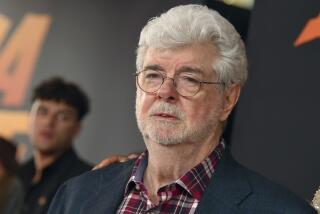Leo-Arthur Kelmenson dies at 84; adman helped save Chrysler
Before advertising executive Leo-Arthur Kelmenson could ignite the media blitz in 1979 that helped rescue Chrysler Corp. from bankruptcy, he had to persuade the auto company’s president to serve as pitchman.
Lee Iacocca’s response was as blunt as the ads that followed: He told the adman to drop dead. But the auto executive soon did what Kelmenson had asked.
The straight-shooting ads “raised the question that was on everybody’s mind,” Kelmenson later said, “Would America be better off without Chrysler?”
The print ad carrying that headline — and others that were equally forthright — helped bring about a government bailout and saved the automaker, said Jerry Greenwald, a former Chrysler executive who worked with Kelmenson.
Kelmenson, whose career in advertising spanned six decades, died Aug. 30 at his home in Remsenburg, N.Y., after a long illness, said his wife, Gayle. He was 84.
“What made him great in the ad business was a combination of courage, straightforwardness, client-centrism and the belief in the magic that creative advertising could provide,” said David Bell, former chief executive of the Bozell Worldwide agency, which Kelmenson once chaired.
He was the chief executive of New York City ad agency Kenyon & Eckhardt when he decided that his firm should walk away from an $80-million-a-year contract with Ford Motor Co. to follow Iacocca to Chrysler. The pair had bonded at Ford, which had recently fired Iacocca as president.
After stripping two agencies of their Chrysler accounts, Iacocca handed Kelmenson’s team an estimated $120 million a year in business. At the time, it was the largest account shift in U.S. history — and it stunned the advertising world.
“I put my company in jeopardy when I went with Chrysler, and there were one or two periods when I wasn’t sure whether or not we would go down the tube,” Kelmenson told The Times in 1982. “But the opportunity was just too big and challenging to pass up.”
In the first wave of TV commercials, broadcast in 1980, Iacocca barked into the camera, “If you can find a better car, buy it.” Yet he came across as “upfront, reasonable,” Time magazine said in 1985.
“The country was starved for leadership and charisma,” Kelmenson told the magazine as he explained Iacocca’s appeal. “Lee talked directly to the American people.”
The ads turned the auto executive into a folk hero, but Kelmenson was “absolutely the driving force” behind the campaign, Greenwald said.
“Leo was loyal, creative and tenacious once he grabbed hold of a project,” Greenwald said. “When he believed in something, he did his darndest to make it work.”
Kelmenson was born Jan. 3, 1927, in New York City and named Leo-Arthur in keeping with a family tradition to append “Arthur” to the first-born son’s name. His father’s family owned a business, United Cooperage, that made barrels and vats.
At 17, he left high school and lied about his age so he could enlist in the Marines during World War II. He was awarded medals for bravery and, as a private, led his unit on the beach in Okinawa after his commander collapsed under heavy fire, his wife said.
Eventually, he ended up recuperating from war injuries in Oceanside, making his first Hollywood connections when an uncle who worked at Warner Bros. sent celebrities to entertain the troops.
At Columbia University, Kelmenson studied international relations, earning a bachelor’s degree in 1951. He also spent two years at the Career Diplomat School of Geneva.
After starting out in television production, he served as a special project officer for the State Department in the early 1960s.
Later that decade, he jumped into advertising and for more than 30 years led a series of agencies beginning with Kenyon & Eckhardt. Throughout his career, Kelmenson often focused on auto advertising and continued to work in the field until early this year.
“The only thing he wanted to do was protect American industry and the American car business,” his wife said. “That was his love, his passion. And he worked on it almost until the day he died.”
Besides Gayle, his wife of 22 years, Kelmenson is survived by their daughter, Philippa Ruthe; two sons from his first marriage, Todd and Joel; and two grandchildren.
More to Read
Start your day right
Sign up for Essential California for the L.A. Times biggest news, features and recommendations in your inbox six days a week.
You may occasionally receive promotional content from the Los Angeles Times.







